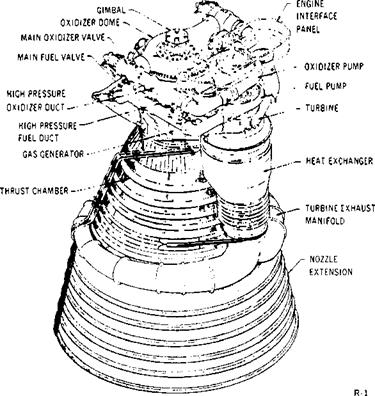FIRST STAGE FLIGHT
The first stage is loaded with RP-1 fuel and LOX at approximately 12 and 4 hours respectively, before launch. With all systems in a ready condition, the stage is ignited by sending a start signal to the five F-l rocket engines. The engine main LOX valves open first allowing LOX to begin to enter the main thrust chamber. Next the engines’ gas generators and turbopumps are started. Each engine’s turbopump assembly will develop approximately 60,000 horsepower. Combustion is initiated by injecting a hypergolic solution into the engine’s main thrust chamber to react with the LOX already present. The main fuel valves then open, and fuel enters the combustion chamber to sustain the reaction previously initiated by the LOX and hypergolic solution. Engine thrust then rapidly builds up to full level. The five engines are started in a 1-2-2 sequence, the center engine first and opposing outboard pairs at 300-millisecond stagger times. The stage is held down while the engines build up full thrust. After full thrust is reached and all engines and stage systems are functioning properly, the stage is released. This is accomplished by a “soft release” mechanism. First, the restraining holddown arms are released. Immediately thereafter the vehicle begins to ascend but with a restraining force caused by tapered metal pins being pulled through holes. This “soft release” lasts for about 500 milliseconds.
SATURN V NEWS REFERENCE
The vehicle rises vertically to an altitude of approximately 430 feet to clear the launch umbilical tower and then begins a pitch and roll maneuver to attain the correct flight azimuth. As the vehicle continues its flight, its path is controlled by gimbaling the outboard F-l engines consistent with a preprogrammed flight path and commanded by the instrument unit.
At approximately 09 seconds into the flight, the vehicle experiences a condition of maximum dynamic pressure. At this time, the restraining drag force is approximately equal to 400,000 pounds.
At 135.5 seconds into the flight most of the LOX and fuel will be consumed, and a signal is sent from the instrument unit to shut down the center engine. The outboard engines continue to burn until either LOX or fuel depletion is sensed. LOX depletion is signaled w’hen a “dry” indication is received from at least two of the four LOX cutoff sensors; one sensor is located near the top of each outboard LOX suction duct. Fuel depletion is signaled by a “dry” indication from a redundant fuel cutoff sensor bolted directly to the fuel tank lower bulkhead. The LOX depletion cutoff is the main cutoff system with fuel cutoff as the backup.
Six hundred milliseconds after the outboard engines receive a cutoff signal, a signal is given to fire the first stage retrorockets. Eight retroroekets are provided and each produces an average effective thrust of 88,600 pounds for 0.666 seconds. The first stage separates from the second stage at an altitude of about 205,000 feet. It then ascends to a peak altitude near 366,000 feet before beginning its descent. While falling, the stage assumes a semistable engines down position and impacts into the Atlantic Ocean at approximately 350 miles down range of Cape Kennedy.
^ SATURN V NEWS REFERENCE
F-l ENGINE FACT SHEET

![]()
LENGTH
WIDTH
THRUST (sea level)
SPECIFIC IMPULSE (minimum)
RATED RUN DURATION FLOWRATE: Oxidizer Fuel
MIXTURE RATIO CHAMBER PRESSURE WEIGHT FLIGHT CONFIGURATION EXPANSION AREA RATIO
COMBUSTION TEMPERATURE: Thrust Chamber
Gas Generator
MAXIMUM NOZZLE EXIT DIAMETER
19 ft.
12 (t. 4 in.
1.500,0 lb.
260 sec.
150 sec.
3,945 lb. sec. (24,811 gpm) 1,738 lb. sec. (15,471 gpm) 2,27:1 oxidizer to fuel 965 psia
18,500 lb. maximum
16:1 with nozzle extension
10:1 without nozzle extension
5,970°F
1,465°F
11 ft. 7 in,
^ SATURN V NEWS REFERENCE










